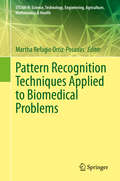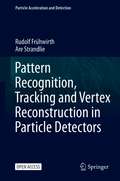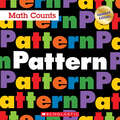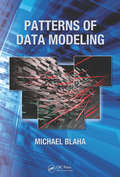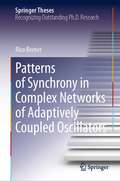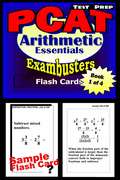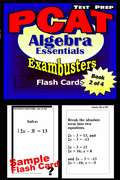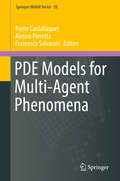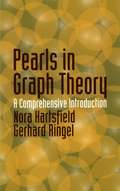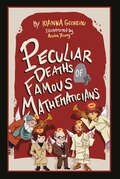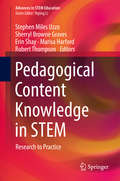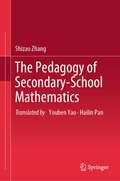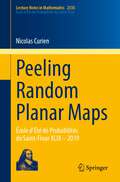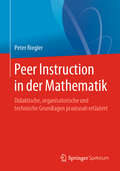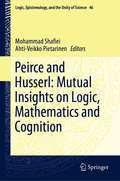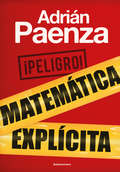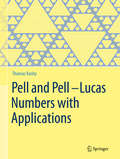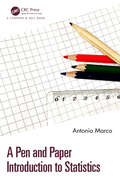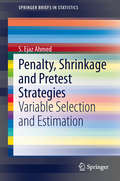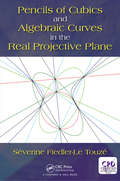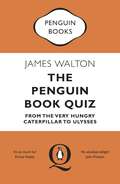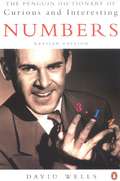- Table View
- List View
Pattern Recognition Techniques Applied to Biomedical Problems (STEAM-H: Science, Technology, Engineering, Agriculture, Mathematics & Health)
by Martha Refugio Ortiz-PosadasThis book covers pattern recognition techniques applied to various areas of biomedicine, including disease diagnosis and prognosis, and several problems of classification, with a special focus on—but not limited to—pattern recognition modeling of biomedical signals and images. Multidisciplinary by definition, the book’s topic blends computing, mathematics and other technical sciences towards the development of computational tools and methodologies that can be applied to pattern recognition processes. In this work, the efficacy of such methods and techniques for processing medical information is analyzed and compared, and auxiliary criteria for determining the correct diagnosis and treatment strategies are recommended and applied. Researchers in applied mathematics, the computer sciences, engineering and related fields with a focus on medical applications will benefit from this book, as well as professionals with a special interest in state-of-the-art pattern recognition techniques as applied to biomedicine.
Pattern Recognition, Tracking and Vertex Reconstruction in Particle Detectors (Particle Acceleration and Detection)
by Rudolf Frühwirth Are StrandlieThis open access book is a comprehensive review of the methods and algorithms that are used in the reconstruction of events recorded by past, running and planned experiments at particle accelerators such as the LHC, SuperKEKB and FAIR. The main topics are pattern recognition for track and vertex finding, solving the equations of motion by analytical or numerical methods, treatment of material effects such as multiple Coulomb scattering and energy loss, and the estimation of track and vertex parameters by statistical algorithms. The material covers both established methods and recent developments in these fields and illustrates them by outlining exemplary solutions developed by selected experiments. The clear presentation enables readers to easily implement the material in a high-level programming language. It also highlights software solutions that are in the public domain whenever possible. It is a valuable resource for PhD students and researchers working on online or offline reconstruction for their experiments.
Patterns (Math Counts: Updated Editions)
by Henry PluckroseAn introduction to capacity for the youngest readers!Math Counts series introduces young readers (grades K-3) to early math concepts. Real-world examples and corresponding photos make math concepts easy to grasp.There are patterns almost everywhere. Recognizing them just takes a little practice.
Patterns of Data Modeling
by Michael BlahaBest-selling author and database expert with more than 25 years of experience modeling application and enterprise data, Dr. Michael Blaha provides tried and tested data model patterns, to help readers avoid common modeling mistakes and unnecessary frustration on their way to building effective data models. Unlike the typical methodology book, Patterns of Data Modeling provides advanced techniques for those who have mastered the basics. Recognizing that database representation sets the path for software, determines its flexibility, affects its quality, and influences whether it succeeds or fails, the text focuses on databases rather than programming. It is one of the first books to apply the popular patterns perspective to database systems and data models. It offers practical advice on the core aspects of applications and provides authoritative coverage of mathematical templates, antipatterns, archetypes, identity, canonical models, and relational database design.
Patterns of Synchrony in Complex Networks of Adaptively Coupled Oscillators (Springer Theses)
by Rico BernerThe focus of this thesis is the interplay of synchrony and adaptivity in complex networks. Synchronization is a ubiquitous phenomenon observed in different contexts in physics, chemistry, biology, neuroscience, medicine, socioeconomic systems, and engineering. Most prominently, synchronization takes place in the brain, where it is associated with cognitive capacities like learning and memory, but is also a characteristic of neurological diseases like Parkinson and epilepsy. Adaptivity is common in many networks in nature and technology, where the connectivity changes in time, i.e., the strength of the coupling is continuously adjusted depending upon the dynamic state of the system, for instance synaptic neuronal plasticity in the brain. This research contributes to a fundamental understanding of various synchronization patterns, including hierarchical multifrequency clusters, chimeras and other partial synchronization states. After a concise survey of the fundamentals of adaptive and complex dynamical networks and synaptic plasticity, in the first part of the thesis the existence and stability of cluster synchronization in globally coupled adaptive networks is discussed for simple paradigmatic phase oscillators as well as for a more realistic neuronal oscillator model with spike-timing dependent plasticity. In the second part of the thesis the interplay of adaptivity and connectivity is investigated for more complex network structures like nonlocally coupled rings, random networks, and multilayer systems. Besides presenting a plethora of novel, sometimes intriguing patterns of synchrony, the thesis makes a number of pioneering methodological advances, where rigorous mathematical proofs are given in the Appendices. These results are of interest not only from a fundamental point of view, but also with respect to challenging applications in neuroscience and technological systems.
PCAT Test Prep Flash Cards: Arithmetic Essentials (Exambusters PCAT Workbook #1 of 4)
by Ace Inc.<P><P><i>Advisory: Bookshare has learned that this book offers only partial accessibility. We have kept it in the collection because it is useful for some of our members. Benetech is actively working on projects to improve accessibility issues such as these.</i><P><P> 600 questions and answers highlight essential arithmetic definitions, problems, and concepts. <P><P>Topics: Addition, Subtraction, Multiplication, and Division of Whole Numbers; Fractions and Decimals, Multiplication Tables, Word Problems, Percents, Measurement, Metric System, Square Roots and Powers, Real Numbers, Properties of Numbers<P>Exambusters PCAT Prep Workbooks provide comprehensive, fundamental PCAT review--one fact at a time--to prepare students to take practice PCAT tests. Each PCAT study guide focuses on one specific subject area covered on the PCAT exams. From 300 to 600 questions and answers, each volume in the PCAT series is a quick and easy, focused read. Reviewing PCAT flash cards is the first step toward more confident PCAT preparation and ultimately, higher PCAT exam scores!
PCAT Test Prep Flash Cards: Algebra Essentials (Exambusters PCAT Workbook #2 of 4)
by Ace Inc.<P><P><i>Advisory: Bookshare has learned that this book offers only partial accessibility. We have kept it in the collection because it is useful for some of our members. Benetech is actively working on projects to improve accessibility issues such as these.</i><P><P> 450 questions and answers that highlight introductory algebra definitions, problems, and concepts.<P><P> Topics: Algebraic Concepts, Sets, Variables, Exponents, Properties of Numbers, Simple Equations, Signed Numbers, Monomials, Polynomials, Additive and Multiplicative Inverse, Word Problems, Prime Numbers, Factoring, Algebraic Fractions, Ratio and Proportion, Variation, Radicals, Quadratic Equations <P>Exambusters PCAT Prep Workbooks provide comprehensive, fundamental PCAT review--one fact at a time--to prepare students to take practice PCAT tests. Each PCAT study guide focuses on one specific subject area covered on the PCAT exams. From 300 to 600 questions and answers, each volume in the PCAT series is a quick and easy, focused read. Reviewing PCAT flash cards is the first step toward more confident PCAT preparation and ultimately, higher PCAT exam scores!
PDE Models for Multi-Agent Phenomena (Springer INdAM Series #28)
by Pierre Cardaliaguet Alessio Porretta Francesco SalvaraniThis volume covers selected topics addressed and discussed during the workshop “PDE models for multi-agent phenomena,” which was held in Rome, Italy, from November 28th to December 2nd, 2016. The content mainly focuses on kinetic equations and mean field games, which provide a solid framework for the description of multi-agent phenomena. The book includes original contributions on the theoretical and numerical study of the MFG system: the uniqueness issue and finite difference methods for the MFG system, MFG with state constraints, and application of MFG to market competition. The book also presents new contributions on the analysis and numerical approximation of the Fokker-Planck-Kolmogorov equations, the isotropic Landau model, the dynamical approach to the quantization problem and the asymptotic methods for fully nonlinear elliptic equations. Chiefly intended for researchers interested in the mathematical modeling of collective phenomena, the book provides an essential overview of recent advances in the field and outlines future research directions.
Pearls in Graph Theory: A Comprehensive Introduction
by Gerhard Ringel Nora Hartsfield"Innovative introductory text . . . clear exposition of unusual and more advanced topics . . . Develops material to substantial level." -- American Mathematical Monthly"Refreshingly different . . . an ideal training ground for the mathematical process of investigation, generalization, and conjecture leading to the discovery of proofs and counterexamples." -- American Mathematical Monthly" . . . An excellent textbook for an undergraduate course." -- Australian Computer JournalA stimulating view of mathematics that appeals to students as well as teachers, this undergraduate-level text is written in an informal style that does not sacrifice depth or challenge. Based on 20 years of teaching by the leading researcher in graph theory, it offers a solid foundation on the subject. This revised and augmented edition features new exercises, simplifications, and other improvements suggested by classroom users and reviewers. Topics include basic graph theory, colorings of graphs, circuits and cycles, labeling graphs, drawings of graphs, measurements of closeness to planarity, graphs on surfaces, and applications and algorithms. 1994 edition.
Pearls of Functional Algorithm Design
by Richard BirdRichard Bird takes a radically new approach to algorithm design, namely, design by calculation. These 30 short chapters each deal with a particular programming problem drawn from sources as diverse as games and puzzles, intriguing combinatorial tasks, and more familiar areas such as data compression and string matching. Each pearl starts with the statement of the problem expressed using the functional programming language Haskell, a powerful yet succinct language for capturing algorithmic ideas clearly and simply. The novel aspect of the book is that each solution is calculated from an initial formulation of the problem in Haskell by appealing to the laws of functional programming. Pearls of Functional Algorithm Design will appeal to the aspiring functional programmer, students and teachers interested in the principles of algorithm design, and anyone seeking to master the techniques of reasoning about programs in an equational style.
Peasants, Citizens and Soldiers
by Luuk De LigtRecent years have witnessed an intense debate concerning the size of the population of Roman Italy. This book argues that the combined literary, epigraphic and archaeological evidence supports the theory that early-imperial Italy had about six million inhabitants. At the same time the traditional view that the last century of the Republic witnessed a decline in the free Italian population is shown to be untenable. The main foci of its six chapters are military participation rates, demographic recovery after the Second Punic War, the spread of slavery and the background to the Gracchan land reforms, the fast expansion of Italian towns after the Social War, emigration from Italy and the fate of the Italian population during the first 150 years of the Principate.
A Peck of Peaches: A Georgia Number Book
by Carol CraneUsing numbers to introduce topics, many of Georgia's famous people, landmarks, and state symbols are introduced including Martin Luther King Jr., the nine Great Lakes of Georgia, loggerhead sea turtles, and sharks' teeth.
Peculiar Deaths of Famous Mathematicians
by Ioanna GeorgiouGetting and keeping teens interest in mathematics is vital to their future. But how, when there are so many dreary textbooks and repetitive curriculum requirements? Covering everything that they need to know is about all a school can do.What approach would work, when there are million other things for them to do?Ioanna Georgiou and Asuka Young have come up with a novel approach that is based on stories from history – with a twist! Peculiar Deaths combines short stories about key mathematicians from the past and how they died, with details of the mathematical advances that they made. But one of the deaths is made up – but which one?Can Beans Kill You? - Pythagoras Death by Square Root - Hippasus You should not be Disturbing my Circles! - ArchimedesWhat? A Woman Mathematician? Die! - HypatiaA bit of Gambling Killed No-one, Ever - Gerolamo Cardano A Very Rich Way to Die - Tycho Brahe Death by Time Calculation - Abraham De Moivre Just a Bit Too Young - Evariste Galois At the Mental Asylum - Andre Bloch Self-imposed Starvation and other Difficulties - Kurt Gö delFunny and enjoyable stories, with visual puzzles throughoutA great way to learn about mathematics of the past, and for students age 13 and over to enjoy learning and understand key concepts. Perfect for libraries, clubs and as prizes too.
Pedagogical Content Knowledge in STEM: Research to Practice (Advances in STEM Education)
by Stephen Miles Uzzo Sherryl Browne Graves Erin Shay Marisa Harford Robert ThompsonThis volume represents both recent research in pedagogical content knowledge (PCK) in science, technology, engineering and math (STEM), as well as emerging innovations in how PCK is applied in practice. The notion of “research to practice” is critical to validating how effectively PCK works within the clinic and how it can be used to improve STEM learning. As the need for more effective educational approaches in STEM grows, the importance of developing, identifying, and validating effective practices and practitioner competencies are needed. This book covers a wide range of topics in PCK in different school levels (middle school, college teacher training, teacher professional development), and different environments (museums, rural). The contributors believe that vital to successful STEM education practice is recognition that STEM domains require both specialized domain knowledge as well as specialized pedagogical approaches. The authors of this work were chosen because of their extensive fieldwork in PCK research and practice, making this volume valuable to furthering how PCK is used to enlighten the understanding of learning, as well as providing practical instruction. This text helps STEM practitioners, researchers, and decision-makers further their interest in more effective STEM education practice, and raises new questions about STEM learning.
The Pedagogy of Secondary-School Mathematics
by Shizao ZhangThis book elucidates the principal aspects and characteristics of secondary school mathematics teaching and learning in China. It combines the cultivation of students' mathematical abilities with the improvement of teaching skills, and explores from both theory and practice to create mathematical pedagogy which has been widely recognized by experts in this field. This book presents a number of mathematics teaching principles and methods, and has been used as an important resource book for mathematics teachers’ education.
Peeling Random Planar Maps: École d’Été de Probabilités de Saint-Flour XLIX – 2019 (Lecture Notes in Mathematics #2335)
by Nicolas CurienThese Lecture Notes provide an introduction to the study of those discrete surfaces which are obtained by randomly gluing polygons along their sides in a plane. The focus is on the geometry of such random planar maps (diameter, volume growth, scaling and local limits...) as well as the behavior of statistical mechanics models on them (percolation, simple random walks, self-avoiding random walks...).A “Markovian” approach is adopted to explore these random discrete surfaces, which is then related to the analogous one-dimensional random walk processes. This technique, known as "peeling exploration" in the literature, can be seen as a generalization of the well-known coding processes for random trees (e.g. breadth first or depth first search). It is revealed that different types of Markovian explorations can yield different types of information about a surface. Based on an École d'Été de Probabilités de Saint-Flour course delivered by the author in 2019, the book is aimed at PhD students and researchers interested in graph theory, combinatorial probability and geometry. Featuring open problems and a wealth of interesting figures, it is the first book to be published on the theory of random planar maps.
Peer Instruction in der Mathematik: Didaktische, organisatorische und technische Grundlagen praxisnah erläutert
by Peter RieglerSie möchten Ihre Lehrveranstaltungen aktivierender und wirksamer gestalten? Sie möchten die Verständnisschwierigkeiten Ihrer Studierenden besser erkennen und verstehen? Sie möchten die studentische Beteiligung steigern, zum Nachdenken und Diskutieren anregen? Lernen Sie das Potenzial von Clickerfragen für die akademische Lehre kennen – damit es bei Ihren Studierenden klick macht! In diesem Buch werden die Grundlagen der interaktiv-dialogischen Lehrmethode praxisnah erläutert. Dabei werden auch häufige Fragen zu didaktischen, organisatorischen und technischen Aspekten beantwortet, etwa:Was ist die Grundidee von Peer Instruction?Wie wirksam ist Peer Instruction? Wie überzeuge ich meine Studierenden davon?Welche technischen Voraussetzungen gibt es?Wie stelle ich gute Clickerfragen?Was sollte ich sonst noch beachten?
Peirce and Husserl: Mutual Insights on Logic, Mathematics and Cognition (Logic, Epistemology, and the Unity of Science #46)
by Mohammad Shafiei Ahti-Veikko PietarinenThis volume aims to provide the elements for a systematic exploration of certain fundamental notions of Peirce and Husserl in respect with foundations of science by means of drawing a parallelism between their works. Tackling a largely understudied comparison between these two contemporary philosophers, the authors highlight the significant similarities in some of their fundamental ideas. This volume consists of eleven chapters under four parts. The first part concerns methodologies and main principles of the two philosophers. An introductory chapter outlines central historical and systematical themes arising out of the recent scholarship on Peirce and Husserl. The second part is on logic, its Chapters dedicated to the topics from Peirce’s Existential Graphs and the philosophy of notation to Husserl’s notions of pure logic and transcendental logic. The third part includes contributions on philosophy of mathematics. Chapters in the final part deal with the theory of cognition, consciousness and intentionality. The closing chapter provides an extended glossary of central terms of Peirce’s theory of phaneroscopy, explaining them from the viewpoint of the theory of cognition.
¡Peligro! Matemática explícita
by Adrián PaenzaUn verdadero festival de problemas, paradojas, dilemas e historias extraordinarias, conducido por el mejor divulgador de matemática del mundo. Cuenta Adrián que tiene la costumbre de guardar, en el bolsillo izquierdo de la camisa, papelitos con anotaciones sobre cosas que le suceden, que observa o le comentan, y que después esos apuntes se convierten en los problemas de sus libros. Es que la matemática está mucho más presente en la vida cotidiana de lo que parece, y si aprendemos a ver con un poco de curiosidad, se encuentra en todos lados. Desafíos en torno a una hamburguesa; cámaras que registran todos los movimientos de la pelota en un partido; cómo es el sorteo de las causas en los juzgados judiciales; decisiones de la inteligencia artificial; problemas sobre la verdad, la verosimilitud y la falsedad; Lennon o McCartney; Voltaire y el FMI; cómo repartir los bienes de una herencia; historias sobre bitcoins y blockchain; tatuajes increíbles; un museo muy inquietante, cómo cambiar reglas injustas y muchos más.
Pell and Pell-Lucas Numbers with Applications
by Thomas KoshyPell and Pell-Lucas numbers, like the well-known Fibonacci and Catalan numbers, continue to intrigue the mathematical world with their beauty and applicability. They offer opportunities for experimentation, exploration, conjecture, and problem-solving techniques, connecting the fields of analysis, geometry, trigonometry, and various areas of discrete mathematics, number theory, graph theory, linear algebra, and combinatorics. Pell and Pell-Lucas numbers belong to an extended Fibonacci family as a powerful tool for extracting numerous interesting properties of a vast array of number sequences. A key feature of this work is the historical flavor that is interwoven into the extensive and in-depth coverage of the subject. An interesting array of applications to combinatorics, graph theory, geometry, and intriguing mathematical puzzles is another highlight engaging the reader. The exposition is user-friendly, yet rigorous, so that a broad audience consisting of students, math teachers and instructors, computer scientists and other professionals, along with the mathematically curious will all benefit from this book. Finally, Pell and Pell-Lucas Numbers provides enjoyment and excitement while sharpening the reader's mathematical skills involving pattern recognition, proof-and-problem-solving techniques.
A Pen and Paper Introduction to Statistics
by Antonio MarcoStatistics is central in the biosciences, social sciences and other disciplines, yet many students often struggle to learn how to perform statistical tests, and to understand how and why statistical tests work. Although there are many approaches to teaching statistics, a common framework exists between them: starting with probability and distributions, then sampling from distribution and descriptive statistics and later introducing both simple and complex statistical tests, typically ending with regression analysis (linear models). This book proposes to reverse the way statistics is taught, by starting with the introduction of linear models. Today, many statisticians know that the one unifying principle of statistical tests is that most of them are instances of linear models. This teaching method has two advantages: all statistical tests in a course can be presented under the same unifying framework, simplifying things; second, linear models can be expressed as lines over squared paper, replacing any equation with a drawing. This book explains how and why statistics works without using a single equation, just lines and squares over grid paper. The reader will have the opportunity to work through the examples and compute sums of squares by just drawing and counting, and finally evaluating whether observed differences are statistically significant by using the tables provided. Intended for students, scientists and those with little prior knowledge of statistics, this book is for all with simple and clear examples, computations and drawings helping the reader to not only do statistical tests but also understand statistics.
Penalty, Shrinkage and Pretest Strategies
by S. Ejaz AhmedThe objective of this book is to compare the statistical properties of penalty and non-penalty estimation strategies for some popular models. Specifically, it considers the full model, submodel, penalty, pretest and shrinkage estimation techniques for three regression models before presenting the asymptotic properties of the non-penalty estimators and their asymptotic distributional efficiency comparisons. Further, the risk properties of the non-penalty estimators and penalty estimators are explored through a Monte Carlo simulation study. Showcasing examples based on real datasets, the book will be useful for students and applied researchers in a host of applied fields. The book's level of presentation and style make it accessible to a broad audience. It offers clear, succinct expositions of each estimation strategy. More importantly, it clearly describes how to use each estimation strategy for the problem at hand. The book is largely self-contained, as are the individual chapters, so that anyone interested in a particular topic or area of application may read only that specific chapter. The book is specially designed for graduate students who want to understand the foundations and concepts underlying penalty and non-penalty estimation and its applications. It is well-suited as a textbook for senior undergraduate and graduate courses surveying penalty and non-penalty estimation strategies, and can also be used as a reference book for a host of related subjects, including courses on meta-analysis. Professional statisticians will find this book to be a valuable reference work, since nearly all chapters are self-contained.
Pencils of Cubics and Algebraic Curves in the Real Projective Plane
by Séverine Fiedler - Le TouzéPencils of Cubics and Algebraic Curves in the Real Projective Plane thoroughly examines the combinatorial configurations of n generic points in RP². Especially how it is the data describing the mutual position of each point with respect to lines and conics passing through others. <P><P>The first section in this book answers questions such as, can one count the combinatorial configurations up to the action of the symmetric group? How are they pairwise connected via almost generic configurations? These questions are addressed using rational cubics and pencils of cubics for n = 6 and 7. The book’s second section deals with configurations of eight points in the convex position. Both the combinatorial configurations and combinatorial pencils are classified up to the action of the dihedral group D8. Finally, the third section contains plentiful applications and results around Hilbert’s sixteenth problem. <P><P>The author meticulously wrote this book based upon years of research devoted to the topic. The book is particularly useful for researchers and graduate students interested in topology, algebraic geometry and combinatorics. <P><P>Features: <li>Examines how the shape of pencils depends on the corresponding configurations of points <li>Includes topology of real algebraic curves <li>Contains numerous applications and results around Hilbert’s sixteenth problem <P><P>About the Author: <P><P>Séverine Fiedler-le Touzé has published several papers on this topic and has been invited to present at many conferences. She holds a Ph.D. from University Rennes1 and was a post-doc at the Mathematical Sciences Research Institute in Berkeley, California.
The Penguin Book Quiz: From The Very Hungry Caterpillar to Ulysses – The Perfect Gift!
by James WaltonTHE PERFECT QUIZ BOOK FOR BOOKWORMS!Which Haruki Murakami novel shares its title with a Beatles song? In Roald Dahl's Charlie and the Chocolate Factory, what is Charlie's surname? What is heavy-drinking Rachel Watson known as in the title of a 21st-century bestseller? And what do you get if you add the number of Bennet sisters in Jane Austen's Pride and Prejudice to the number of Karamazov brothers in Fyodor Dostoevsky's The Brothers Karamazov?With four hundred questions covering books from literary classics to modern bestsellers, through iconic children's books and books you say that you've read but really you haven't, The Penguin Book Quiz is as appropriate for a making you look well-read at a party as it is for a book-loving family to tuck into after Christmas dinner: it's as enjoyable to read as it is to play.Featuring the work of everyone from Antony Beevor to Zadie Smith, books from The Very Hungry Caterpillar to Ulysses, and with movie, music, television and literary references abound, this entertaining quiz tickles the fancy (and the brains) of light and heavy readers alike.Answers:- Norwegian Wood- Bucket- The Girl on the Train- Eight (five sisters, three brothers)
The Penguin Dictionary of Curious and Interesting Numbers
by David WellsWhy was the number of Hardy's taxi significant? Why does Graham's number need its own notation? How many grains of sand would fill the universe? What is the connection between the Golden Ratio and sunflowers? Why is 999 more than a distress call? All these questions and a host more are answered in this fascinating book, which has now been newly revised, with nearly 200 extra entries and some 250 additions to the original entries. From minus one and its square root, via cyclic, weird, amicable, perfect, untouchable and lucky numbers, aliquot sequences, the Cattle problem, Pascal's triangle and the Syracuse algorithm, music, magic and maps, pancakes, polyhedra and palindromes, to numbers so large that they boggle the imagination, all you ever wanted to know about numbers is here. There is even a comprehensive index for those annoying occasions when you remember the name but can't recall the number.
